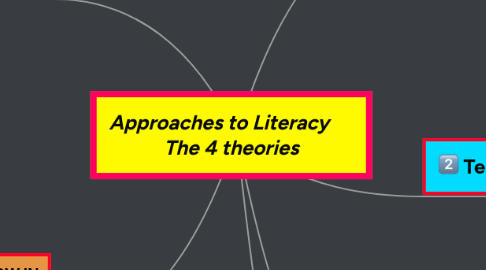
1. WHAT MAKES THIS THEORY STAND OUT OR DIFFERENT?
1.1. New Literacy Studies show more concentration on literacy practices.
2. WHAT MAKES THIS THEORY STAND OUT OR DIFFERENT?
2.1. Critical Literacy shows more concentration on what happens between the learner and the text.
3. WHAT MAKES THIS THEORY STAND OUT OR DIFFERENT?
3.1. Technology Literacy concentrates on how technology in the school differs from the students outside environment.
4. WHAT MAKES THIS THEORY STAND OUT OR DIFFERENT?
4.1. Sociocultural Historical focuses on the learner as an individual and a learner and teacher.
5. Critical Literacy
5.1. Student
5.1.1. Active agents in learning by comparison of texts and their social practices
5.2. Teacher
5.2.1. Helps learner navigate through text, and see how text relates to them as individual.
5.3. Literature
5.3.1. Texts are ideological (power related)
5.4. Practices
5.4.1. Every text is shaped by the writers beliefs and values
5.5. Founded by
5.5.1. Friere
6. Technology Literacy
6.1. Student
6.1.1. Active agents in learning. Knowledge is there but schools don't share same knowledge.
6.2. Teacher
6.2.1. Helps learner move through resources
6.3. Literature
6.3.1. multi modal ( digital and non-digital)
6.4. Practices
6.4.1. rapid developments of technology and is not reflected in school practices.
6.5. Founded by:
6.5.1. Kress
7. Sociocultural Historical
7.1. Student
7.1.1. Active agents in learning
7.2. Teacher
7.2.1. models, scaffolds,coaches, shows, hands over to students.
7.3. Literature
7.3.1. Only used to mediate learning for different uses
7.4. Practices
7.4.1. Broader sociocultural practices that mediate learning
7.5. Founded by:
7.5.1. Cole, Lee and Smagorinsky, and Rogoff
8. HOW DOES THESE 4 THEORIES WORK TOGETHER
8.1. In all theories the learner is seen as an active agent
8.2. In all theories the teachers can have some kind of involvement in the classroom
8.3. All theories identify literacy as something used in a variety of ways in the classroom
8.4. All of these theories display text as multi modal, ideological tool.
8.5. Evens in literacy and their practices can be concepts that have a lot of different understandings.
9. WHAT IS IMPORTANT TO KNOW IN THE 21ST CENTURY TO FULLY UNDERSTAND LITERACY?
9.1. Any theory can be used separately or together.
9.2. There is a need with all models to have authentic literacy practices.
9.3. Cultural differences are important
9.4. Theories should work into lessons smoothly
9.5. Theories not there to restrict, but help teachers
9.6. Teachers have to be open to changes and new things
10. New Literacy Studies
10.1. Student
10.1.1. Active agents in learning.Literacy is formal/informal
10.2. Teacher
10.2.1. Encourages participation in events and the practices
10.3. Literature
10.3.1. Multi modal and multi purposed
10.4. Practices
10.4.1. Social, cultural, historical, and political practices
10.5. Founded by:
10.5.1. Graff, Heath, Scribner and Cole, Street
